Table of Contents
Introduction
According to Rice Statistics, Rice, a staple for over half the world’s population, is a versatile cereal grain with thousands of varieties categorized into long-grain, medium-grain, and short-grain types.
From the slender and separate long-grain to the sticky short-grain varieties, it offers diverse culinary possibilities, including plain steamed rice, sushi, and rice pudding.
While white rice is widely consumed, retaining little of its bran layer, brown preserves more nutrients and fiber.
Beyond its nutritional value, rice holds cultural significance, symbolizing fertility and prosperity in many societies. Whether in religious ceremonies or daily meals, it remains a vital component of global cuisine and heritage.
Editor’s Choice
- The global rice market revenue reached USD 280.4 billion in 2023.
- This robust growth persisted through to 2032, culminating in a total market size of USD 382.2 billion, with long-grain commanding USD 176.6 billion, medium-grain contributing USD 132.6 billion, and short-grain reaching USD 73.0 billion.
- The distribution channels for the market are predominantly dominated by offline sales, which hold an 81% market share.
- From 2022 to 2023, the global rice supply reached 717.84 million metric tons.
- In 2022, the global landscape of rice production (paddy rice) was led by China, which topped the list with a substantial output of 208.49 million metric tonnes.
- India led the market with exports valued at US$10.8 billion, accounting for 36.8% of total exports worldwide.

Rice Market Overview
Global Rice Market Size
- The global rice market has shown a consistent upward trajectory in revenue from 2022 to 2032, a CAGR of 3.6%.
- Starting with a market size of USD 270.7 billion in 2022, the revenue increased to USD 280.4 billion in 2023, demonstrating moderate growth.
- This growth pattern is sustained over the following years, with market revenues projected to be USD 314.7 billion in 2026 and USD 324.6 billion in 2027.
- The upward trend persists into the next decade, with projected revenues of USD 354.5 billion in 2030, USD 367.2 billion in 2031, and finally, reaching USD 382.2 billion by 2032.
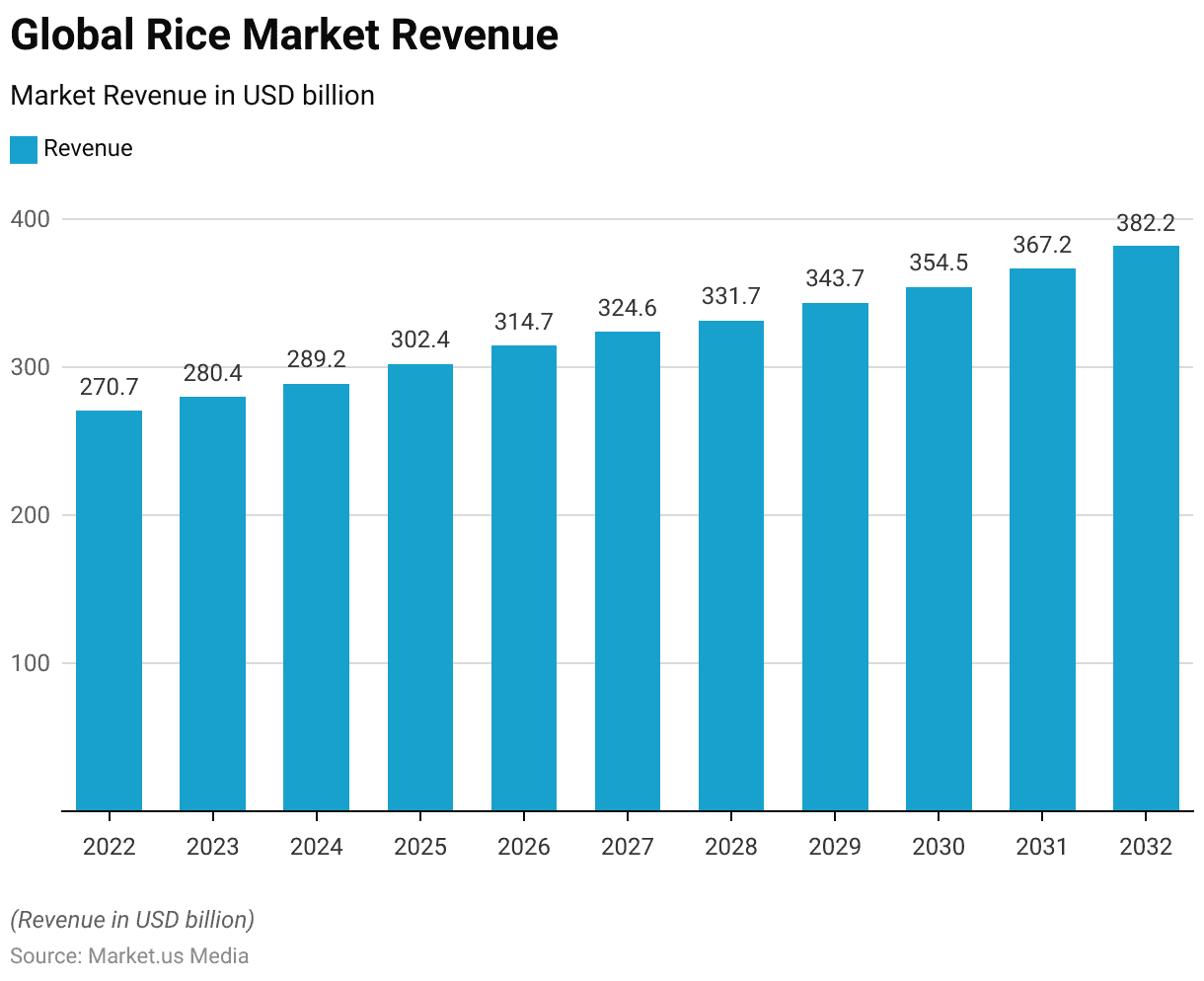
Rice Market Size – By Size
- The global rice market, segmented by grain size, has exhibited consistent growth from 2022 to 2032 across all categories. Starting in 2022, the total market revenue was USD 270.7 billion, split among long-grain at USD 125.1 billion, medium-grain at USD 93.9 billion, and short-grain at USD 51.7 billion.
- This upward trend continued in 2024, with the market expanding to USD 289.2 billion overall, including USD 133.6 billion from long-grain, USD 100.4 billion from medium-grain, and USD 55.2 billion from short-grain.
- This robust growth persisted through to 2032, culminating in a total market size of USD 382.2 billion, with long-grain rice commanding USD 176.6 billion, medium-grain contributing USD 132.6 billion, and short-grain reaching USD 73.0 billion.
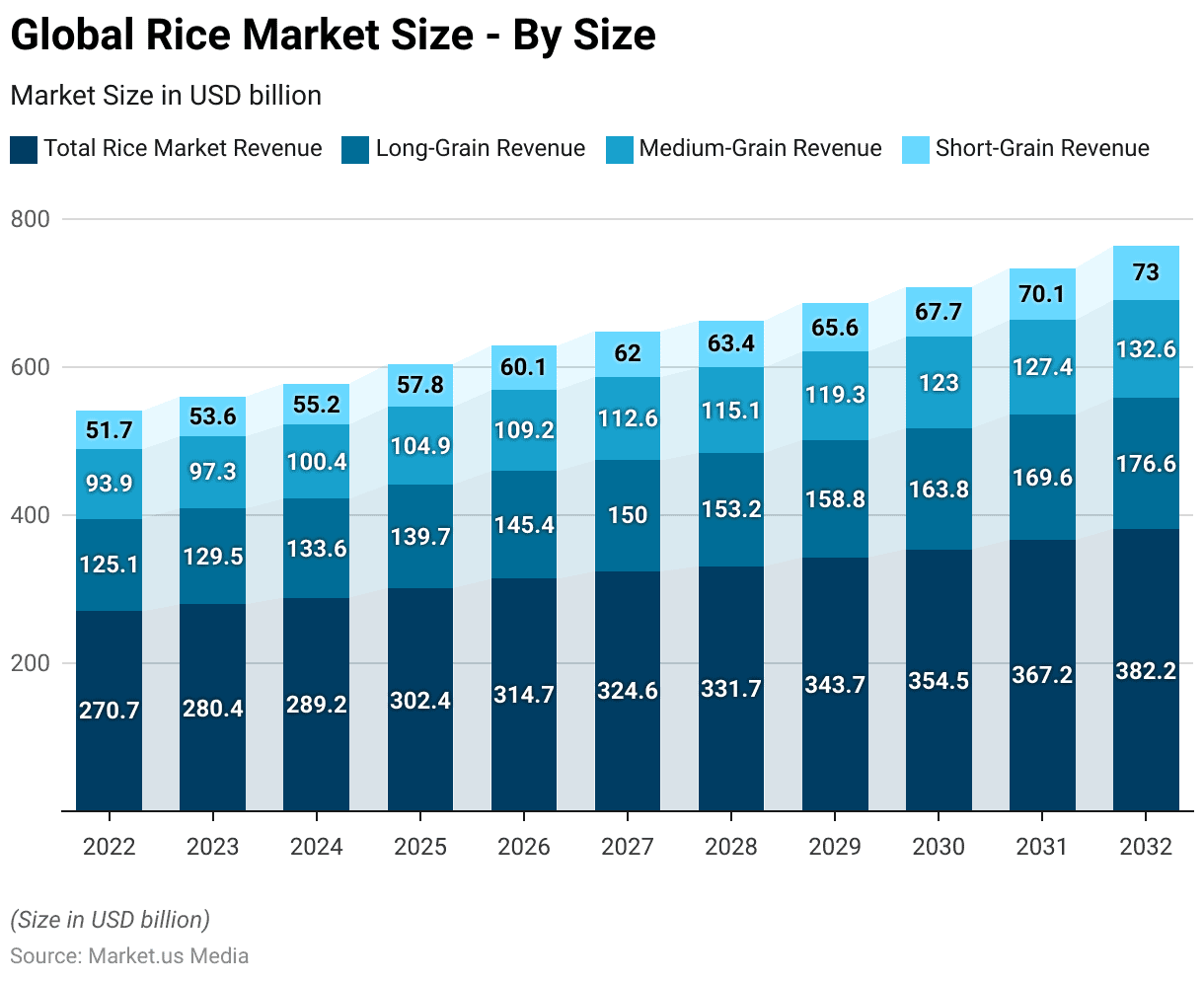
Global Rice Market Share – By Distribution Channel
- The distribution channels for the market are predominantly dominated by offline sales, which hold an 81% market share.
- Conversely, online sales account for 19% of the market.

Nutritional Composition of Rice
- White, long-grain rice, when cooked, provides a nutritional profile for a 100-gram serving as follows:
- It contains 130 calories and has minimal fat, with only 0.3 grams of total fat and 0.1 grams of saturated fat, both contributing 0% to the Daily Value.
- It has no cholesterol and a negligible sodium content of 1 milligram.
- This type offers 35 milligrams of potassium, accounting for about 1% of the Daily Value.
- It is primarily composed of carbohydrates, providing 28 grams, which includes 0.4 grams of dietary fiber and a trace amount of sugar at 0.1 grams.
- The protein content stands at 2.7 grams, making up about 5% of the Daily Value.
Total Global Supply of Rice
- The total global supply of rice, measured in million metric tons, fluctuated over the years from 2014 to 2023.
- Beginning at 712.63 million metric tons in the 2014-2015 marketing year, the supply dipped slightly to 710.64 million metric tons in 2015-2016 before recovering to 711.82 million metric tons in 2016-2017. However, a notable decrease occurred in 2017-2018, with the supply dropping to 673.00 million metric tons, possibly due to various factors such as weather-related disruptions, changes in agricultural practices, or market dynamics.
- Subsequent years showed further improvement, with supply reaching 700.40 million metric tons in 2020-2021 and 720.77 million metric tons in 2021-2022, reflecting a positive trajectory.
- However, in 2022-2023, the supply experienced a slight decline to 717.84 million metric tons.
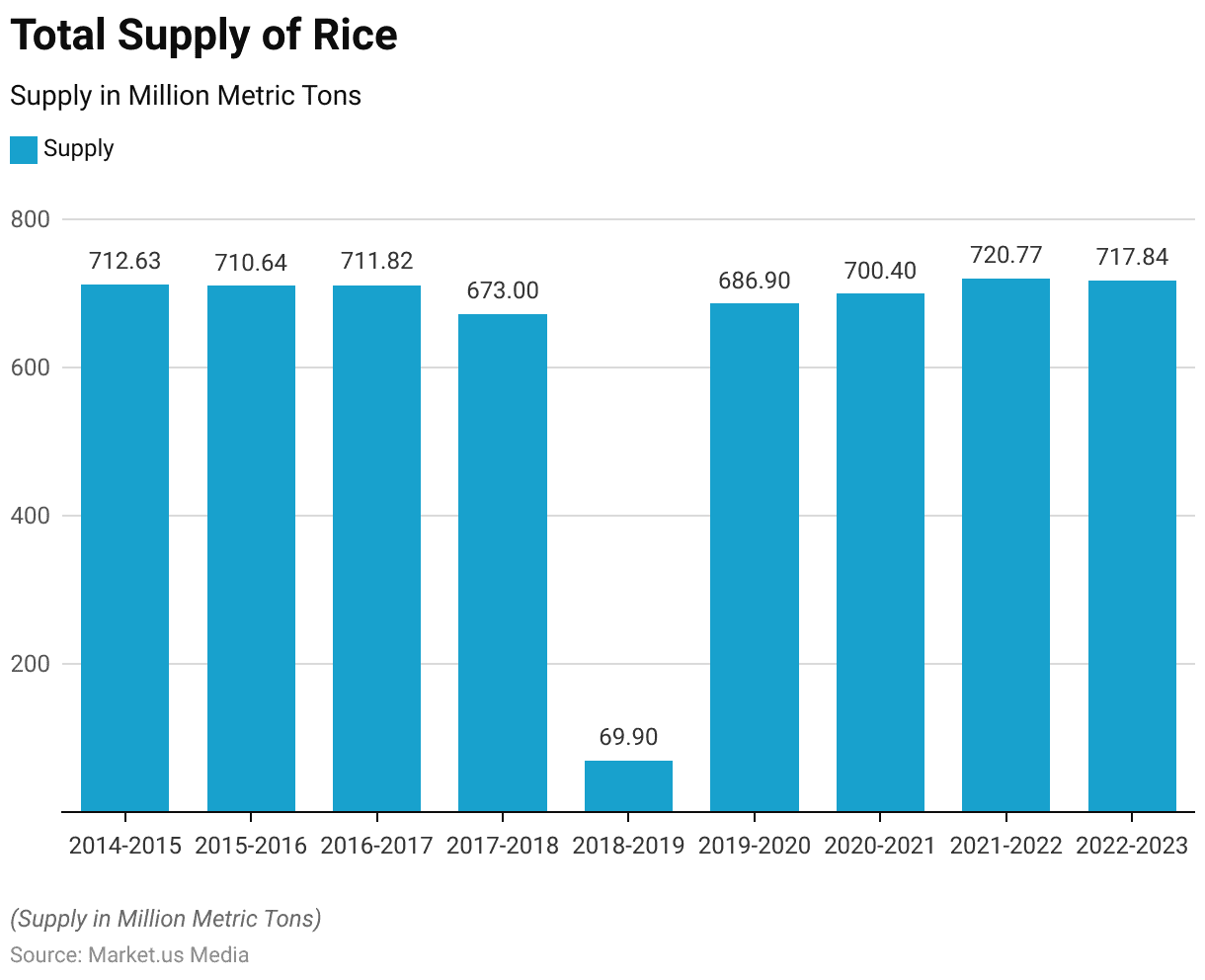
Global Rice Production Statistics
World Production Volume of Milled Rice
- The world production volume of milled rice has shown a generally upward trend, as depicted by the data.
- Starting at 472.90 million metric tons in 2015-2016, production increased steadily to 486.20 million metric tons in 2016-2017 and further to 495.00 million metric tons in 2017-2018.
- The trend continued with slight fluctuations, reaching 498.22 million metric tons in 2018-2019 and 498.18 million metric tons in 2019-2020.
- However, the subsequent years showed a slight decline, with production remaining relatively stable at 512.96 million metric tons in 2022-2023 and slightly edging up to 513.54 million metric tons in 2023-2024.

Top Countries With The Largest Production of Rice
- In 2022, the global landscape of rice production (paddy rice) was led by China, which topped the list with a substantial output of 208.49 million metric tonnes.
- India followed closely as the second-largest producer, yielding 196.25 million metric tonnes.
- Bangladesh secured the third position with a production of 57.19 million metric tonnes, while
- Indonesia and Vietnam ranked fourth and fifth, producing 54.75 million metric tonnes and 42.67 million metric tonnes, respectively.
- Thailand came in sixth with 34.32 million metric tonnes, followed by Myanmar with 24.68 million metric tonnes.
- The Philippines, Cambodia, and Pakistan rounded out the top ten, producing 19.78 million metric tonnes, 11.62 million metric tonnes, and 10.98 million metric tonnes, respectively.

Global Rice Consumption
- The consumption started at 468,862 thousand metric tons in the 2015-2016 period.
- The upward trend continued into 2019-2020, with consumption reaching 493,232 thousand metric tons.
- In the 2020-2021 period, consumption exceeded half a million metric tons, recording a significant rise to 502,692 thousand metric tons.
- The most recent data shows a further increase to 520,437 thousand metric tons in 2022-2023, with projections for 2023-2024 indicating a slight rise to 522,100 thousand metric tons.
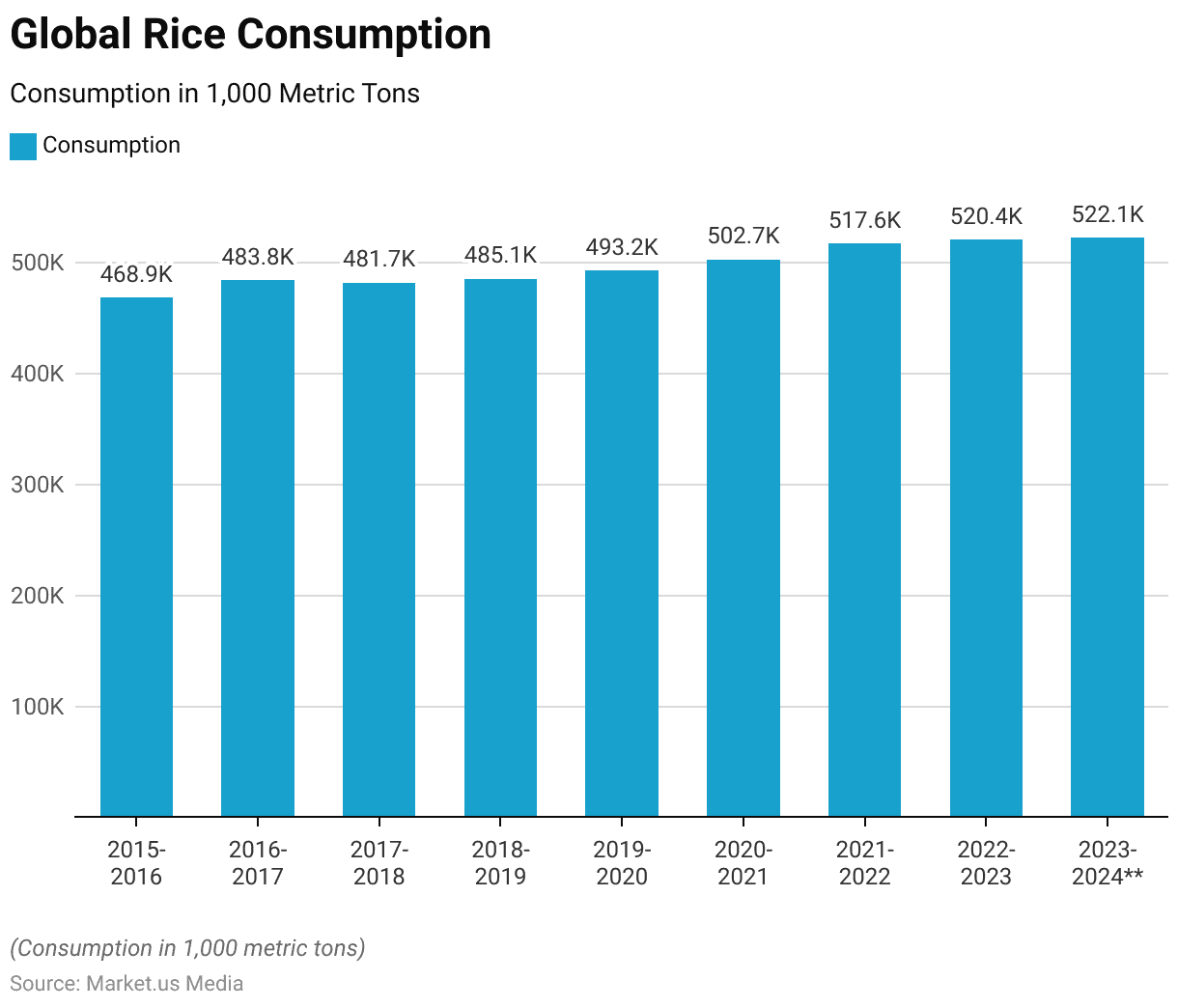
Global Rice Trade Statistics
Top 10 Rice Exporting Countries
- India led the market with exports valued at US$10.8 billion, accounting for 36.8% of total rice exports worldwide.
- Thailand followed as a significant exporter, generating $4 billion and capturing 13.5% of the market share.
- Vietnam also played a key role, with exports worth $2.5 billion, representing 8.6% of the market.
- Close behind, Pakistan exported valued at $2.4 billion, comprising 8% of the global share.
- The United States contributed $1.7 billion in exports, holding 5.8% of the market.
- China’s exports amounted to $1 billion, making up 3.5% of the total.
- Italy and Myanmar were relatively close in their export values at $804.7 million and $786.8 million, respectively, each claiming about 2.7% of the market.

Countries Generating Highest Surpluses Trading Rice
- In 2022, several countries achieved notable trade surpluses in the rice market, each reflecting varying trends since 2021.
- India topped the list with a net export surplus of US$10.8 billion, an increase of 11.8% over the previous year.
- Thailand followed with a surplus of $4 billion, marking an 18.3% rise. Vietnam and Pakistan each reported a surplus of $2.3 billion, with growths of 1.1% and 9.2% respectively.
- Myanmar also saw a significant increase, with its surplus reaching $786.6 million, up 17.4%. Uruguay, with a 30.4% surge, recorded a surplus of $497.3 million.
- However, not all countries saw positive changes; Italy experienced a decrease of 15.4% in its surplus, bringing it down to $451.3 million. Cambodia’s surplus slightly declined by 1.3% to $412.5 million.
Top 10 Rice Importing Countries
- In the 2023/2024 period, several countries emerged as principal importers, reflecting diverse global demand.
- The Philippines led the rankings with imports totaling 3.8 million metric tonnes, followed by China with 2.8 million metric tonnes and Indonesia with 2.5 million metric tonnes.
- Notably, the European Union, acting as a collective entity, imported 2.4 million metric tonnes of rice.
- Nigeria and Iraq each imported 2.1 million metric tonnes, while Cote D’Ivoire, Senegal, Vietnam, and Saudi Arabia imported 1.4 million metric tonnes each.
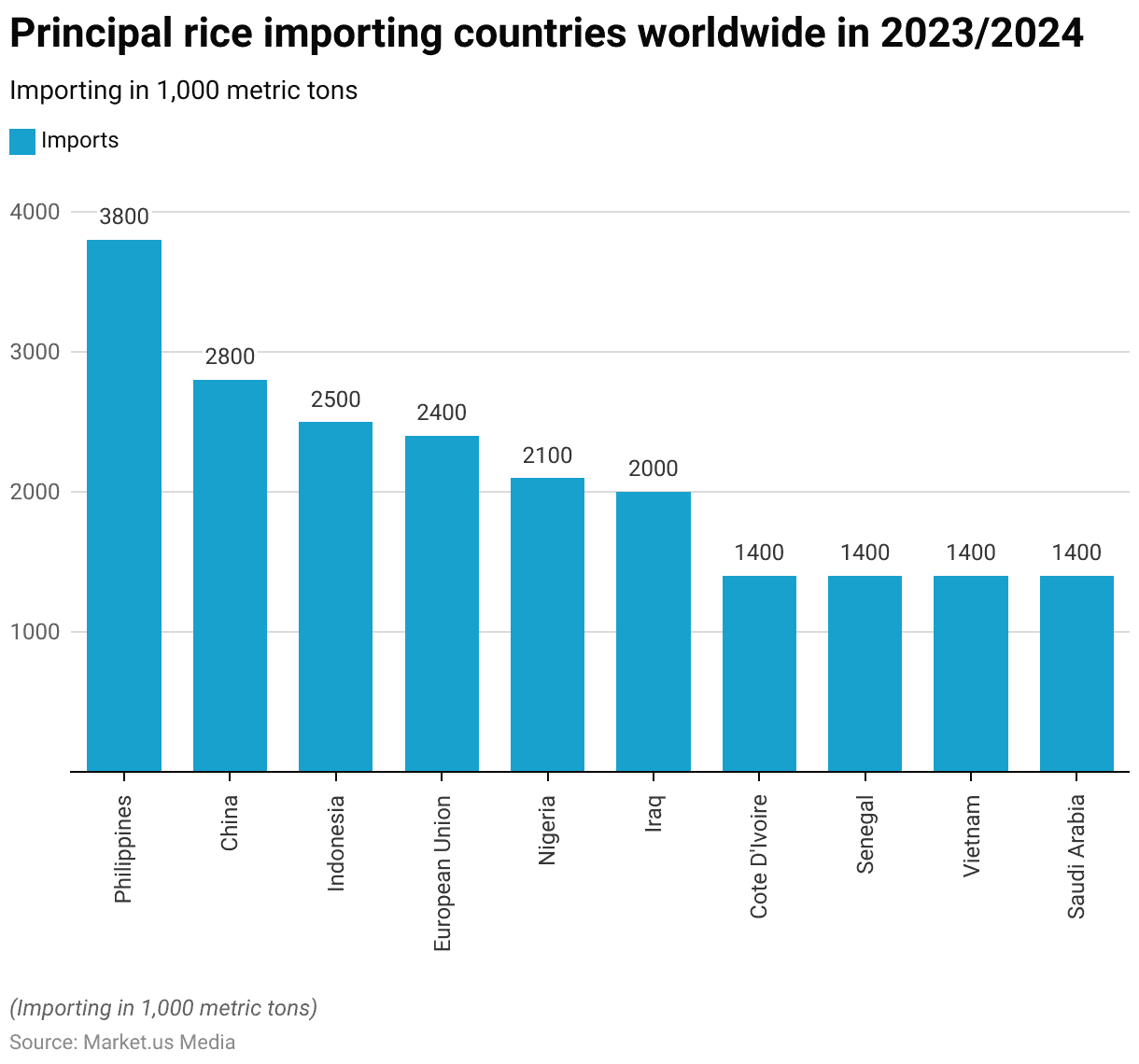
HS Code for Rice
- In the case of rice, different types and processing methods are distinguished by specific HS codes. Unhusked rice, also known as paddy rice, is classified under HS code 1006.10.
- Husked rice, which has had its outer hull removed, is identified by HS code 1006.20.
- Parboiled rice, a type that has been partially boiled in the husk before milling, is designated by HS code 1006.30.
- Semi-milled rice, which undergoes partial milling to remove the husk and some bran layers, has the HS code 1006.40.
- Furthermore, within the category of parboiled rice, specific varieties such as Basmati are further distinguished. Basmati rice, known for its long grains and aromatic qualities, is assigned the HS code 10063020.
Price of Rice Around the Globe
Rice Price Indices Worldwide
- The worldwide rice price indices from 2016 to 2023 depict fluctuations in the global market over this period.
- Starting at 91.4 in 2016, the index climbed steadily to 99 in 2017 and further to 106.3 in 2018, indicating a rising trend in prices.
- The following year, 2021, saw a modest decline to 105.8, suggesting some stabilization in prices.
- Notably, 2022 witnessed a slight uptick in the index, reaching 108.8, indicating a moderate rise.
- However, the most notable shift occurred in 2023, with the index soaring to 132, signifying a substantial spike in prices.
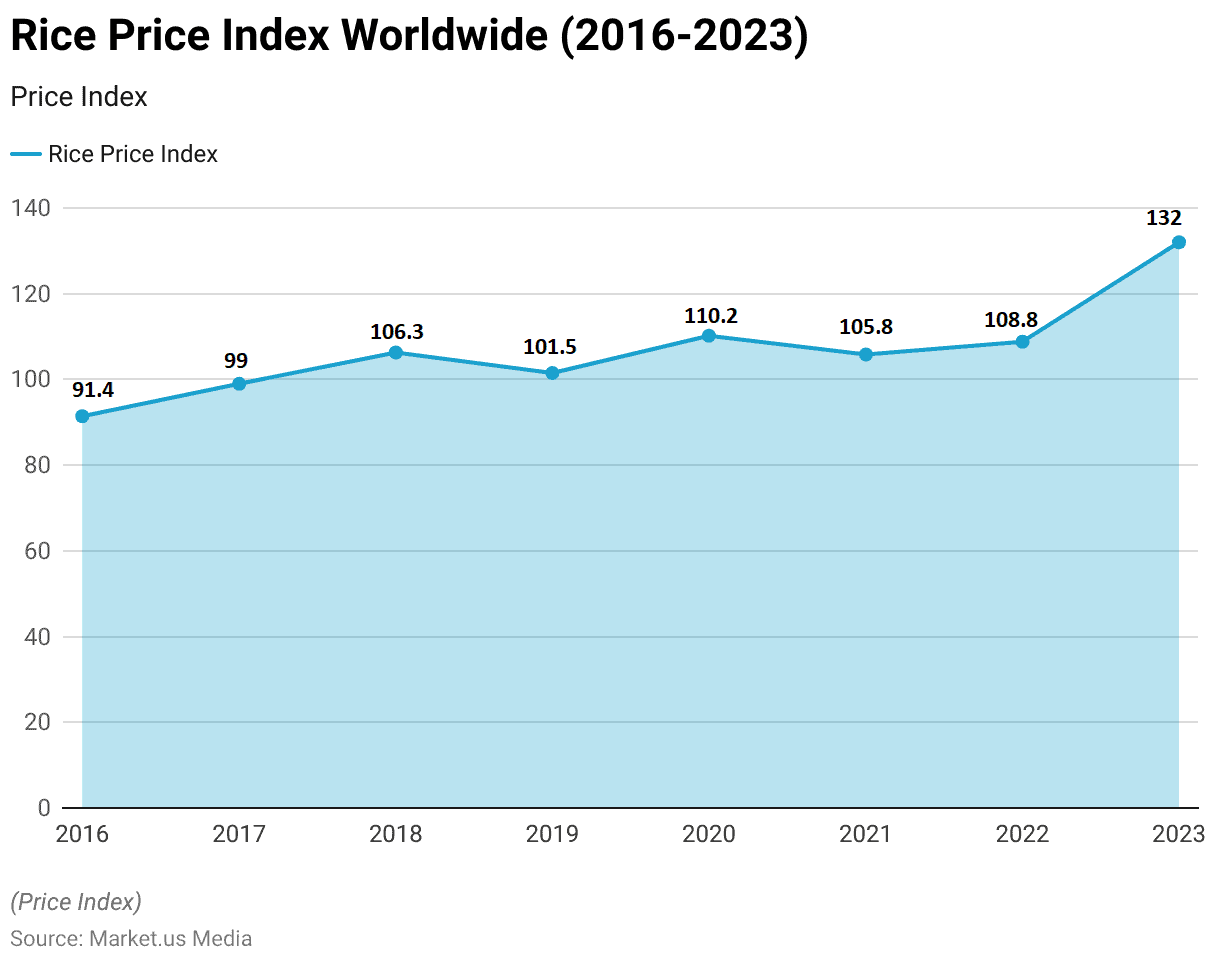
Price Rankings of Rice – By Country
- The price rankings for white rice per kilogram vary across countries, reflecting a range of factors, including production costs, import tariffs, and market demand.
- In the United States, white rice is priced at USD 4.58 per kilogram, indicating relatively higher costs compared to other nations.
- Canada follows closely with a USD 3.68 per kilogram, while Japan and Sweden stand at USD 3.38 and USD 3.30 per kilogram, respectively.
- Switzerland and South Korea exhibit similar pricing, with rates of USD 3.14 and USD 3.09 per kilogram, respectively.
- The Netherlands and Taiwan are also within this range, with prices at USD 3.08 and USD 3.00 per kilogram, respectively.

Consumer Preferences
Frequency of Rice Purchased by Households
- According to survey data, a majority of respondents, accounting for 55%, indicated that they purchase rice every day, indicating a high frequency of consumption.
- Additionally, 35% of respondents reported purchasing once a week, indicating a slightly lower but still significant frequency of consumption among this group.
- Another 5% of respondents stated that they purchase once every four days, suggesting a more frequent consumption pattern compared to weekly buyers.
- Similarly, another 5% of respondents reported purchasing rice fortnightly, indicating a less frequent but still notable consumption frequency.

Consumer Preferences on Imported and Locally Grown Rice
- According to survey data, a majority of respondents, comprising 56%, expressed a preference for locally grown rice.
- In contrast, only 8% of respondents indicated a preference for imported, suggesting a relatively lower demand for rice sourced from other countries.
- However, a significant portion of respondents, representing 20%, stated that they were open to purchasing either locally grown or imported, indicating a level of flexibility and willingness to consider various options based on factors such as availability, price, and quality.
- Additionally, 16% of respondents expressed uncertainty about their preference, indicating a lack of strong inclination towards either option or perhaps insufficient awareness about the differences between locally grown and imported rice.
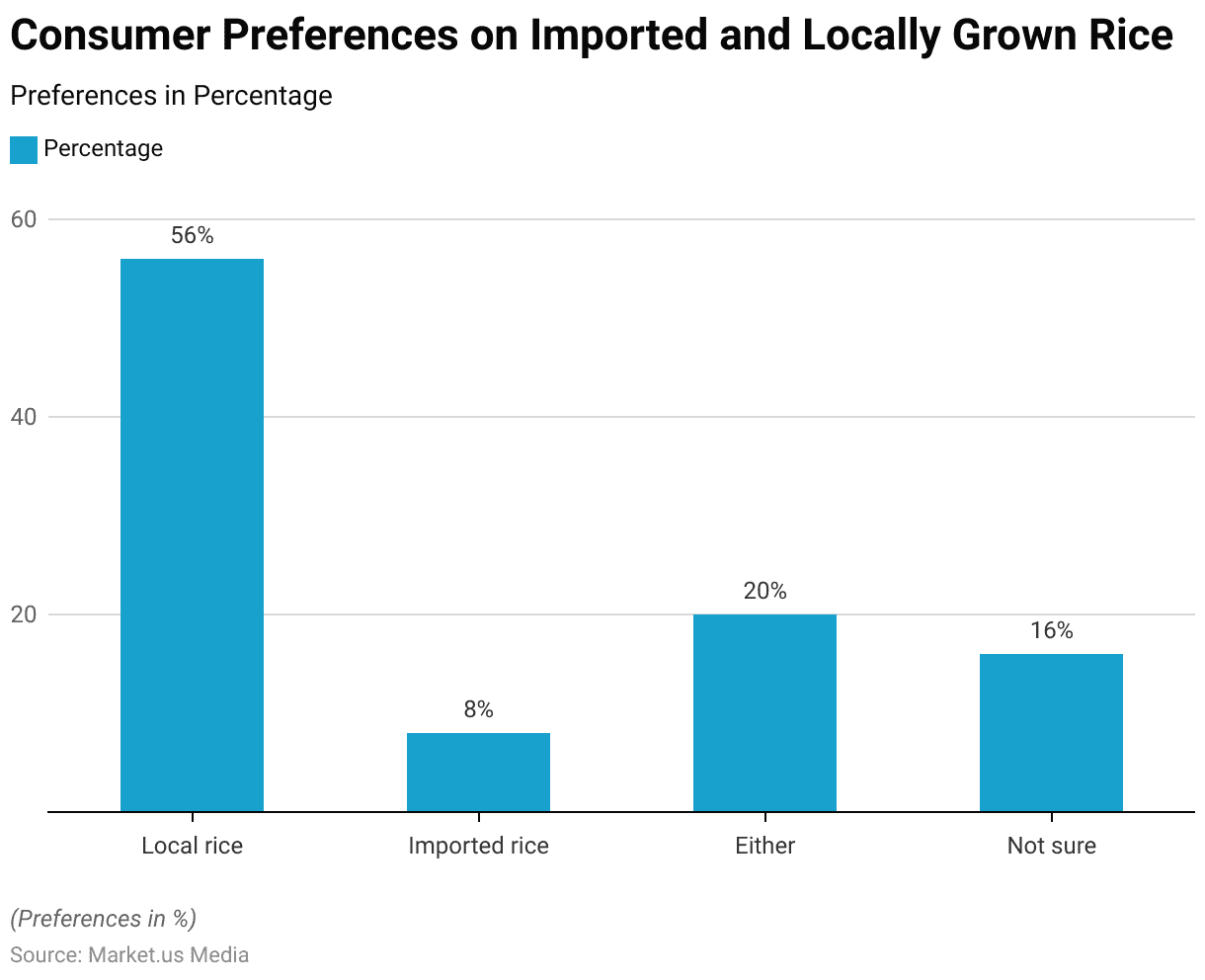
Reasons for Selection of Rice
- Households exhibit varied reasons for their selection of rice, as indicated by survey data. Taste emerged as the primary driver, with ten households emphasizing it as the decisive factor in their choice, suggesting a strong emphasis on flavor preferences.
- Additionally, affordability played a significant role, with 16 households prioritizing low prices when selecting, highlighting the importance of economic considerations in purchasing decisions.
- Furthermore, factors related to characteristics and cooking attributes also influenced selection. For instance, six households considered the length of cooking time, indicating a preference for convenience and efficiency in meal preparation.
- Texture after cooking was another crucial factor, with four households preferring a soft texture and only one household prioritizing a hard texture.

Discuss your needs with our analyst
Please share your requirements with more details so our analyst can check if they can solve your problem(s)



